Our Native American Maple Sugaring Program utilizes an interactive format that includes informal, on-going talks and demonstrations (including hot-stone boiling) with tastes of pure, fresh made Maple sugar hot off the fire from our kettles (and coming soon - we will also be boiling sap in Woodland style earthenware pots!). The program content is a combination of sugaring techniques recorded historically among many Woodland Indian communities (predominantly Ojibwa and Iroquois, with Shawnee, Delaware, Abenaki, etc.). Although we utilize cross-cultural information to present a holistic view of Native Maple sugaring of the past, we do not simplify the practice but instead present it in all its complexity (ex. different Maple sugaring techniques during different times, different molds and material technologies in different areas of the Northeast, the controversy of how and if pre-contact Peoples made dry sugar, etc.). As one Maple syrup producer commented of us, "They're very accurate, and tremendously detailed. They do a fantastic job."
The following are a few pictures of our program and camp set-up.
|
 |
| Hard Maple tree tapped by slashing with a hatchet and inserting a flat stick to guide sap away from tree to the bark bucket below. |
|
|
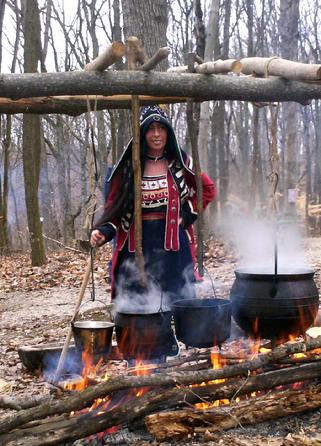 |
| Jessica tending to the boiling sap. The small brass kettle contains boiling syrup that is about to turn into dry sugar. This pot must be watched carefully so that it may not boil over or burn. |
|
|
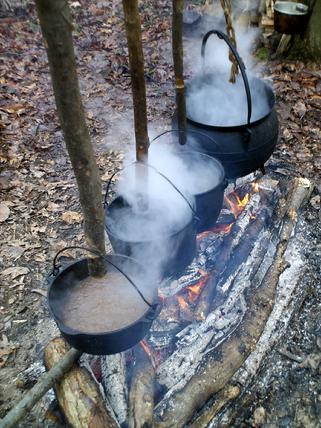 |
| Sap is boiled down in our iron kettles. Fresh sap is boiled in the furthest, largest pot. As the sap loses water content, it is transferred to the next pot, then the next until it ends up in the closer, smaller pot where it becomes syrup. From here, it will be turned into sugar. |
|
|
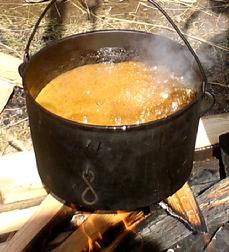 |
| When turning syrup into sugar, it must be at a rapid boil. Care must be taken to regulate the boil so as it stays boiling, but does not boil over. This pot is just about ready to pour and beat into granulated sugar. |
|
|
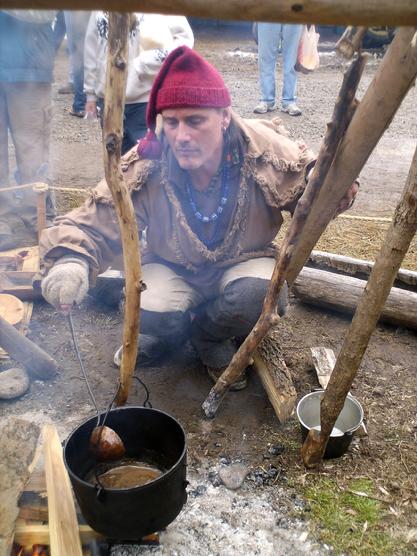 |
| Mark checks the sugar to make sure it is hot enough to crystalize. If it is not hot enough, it will not turn into hard sugar and may then be left on the fire too long, which may burn it. |
|
|
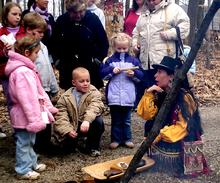 |
| Children listen as Jessica talks about Native American sugar making. |
|
|
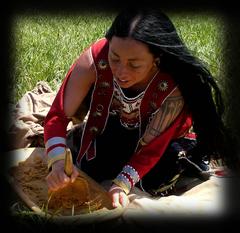 |
| Jessica paddles hot sugar in a granulating trough. |
|
|
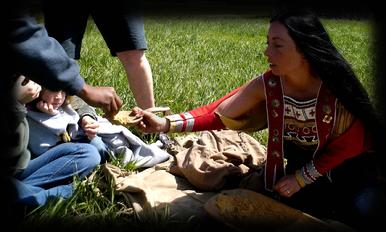 |
| Visitors try freshly made warm Maple sugar. |
|
|
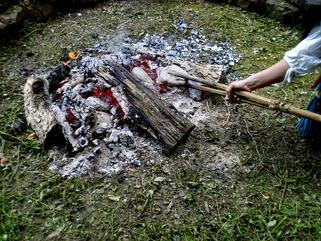 |
| Hot-stone boiling is another method in which Native Peoples of the past reduced sap to syrup. Hot-stone boiling Maple sap begins with rocks heated by a fire. |
|
|
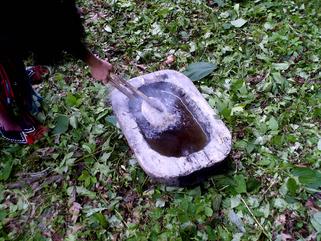 |
| These hot rocks are then placed into the sap using wooded tongs created for this purpose. *Important* Do NOT try this as many kinds of rocks will explode when treated in this manner. |
|
|
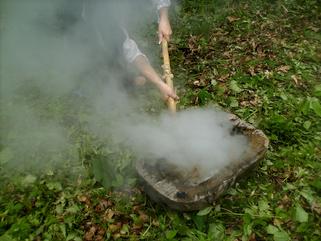 |
| Using this method ensured a lot of evaporation, as indicated by the amount of steam. When compared to pots of sap over the fire, we usually notice much more steam leaving the sap heated with hot stones compared to the sap directly over the fire. |
|
|
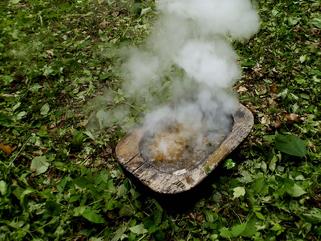 |
| Although it takes a bit to heat the sap up, it is relatively easy to keep the sap boiling once it has reached the boiling point. The rocks are extremely hot, and tend to hold their heat for quite a while. We have kept sap boiling for about 8 minutes before replacing with new, hot rocks from the fire. |
|
|
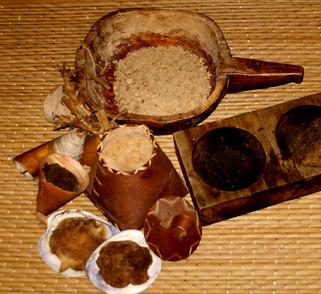 |
| We display Maple sugar in its many varieties, including granulated, crystalized caked, and candied. Our hard sugar is formed in molds made of wood, shell, bark, etc. |
|
|
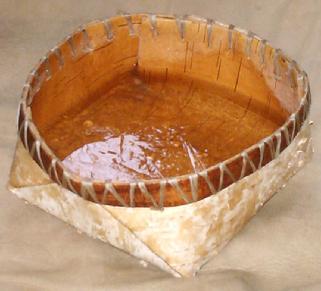 |
| Besides speaking about heating sap to reduce the water content, we also speak about freezing the sap overnight to reduce some of the sap's water. The frozen layer is removed in the morning and discarded, increasing the sap's ratio of sugar to water. |
|
|
 |
| Some usual daily dishes of the Woodland Indian Peoples that would have been sweetened with Maple sugar. For this program, we continue to display a few freshly cooked dishes as well as our display of 14-20 dehydrated storage foods. |
|
|
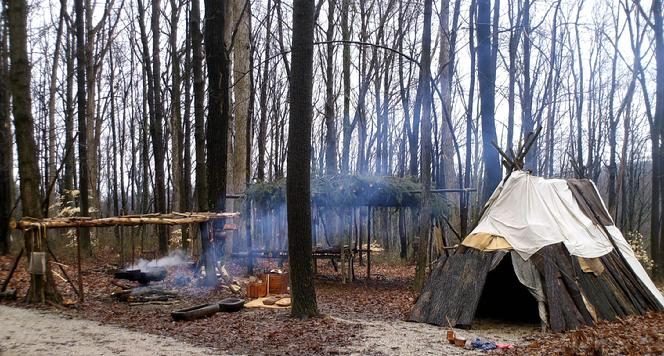 |
| Our Maple sugar camp at the National Maple Syrup Festival. |
|
|
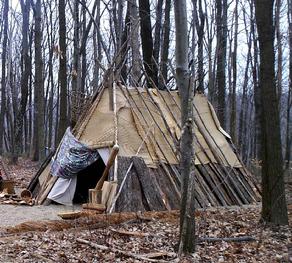 |
| Our A-frame is a classic example of a camp structure utilized in many Western Great Lakes sugar camps. |
|
|
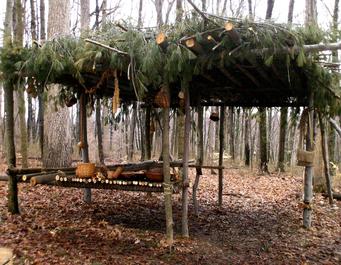 |
| The shade shelter acts as an outdoor kitchen area - an area in which food preparation can be carried out with space and comfort. |
|
|
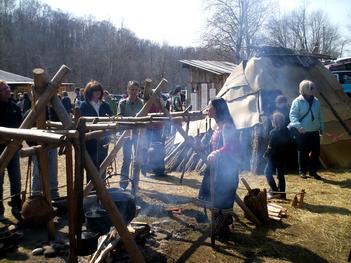 |
| Our demonstration area at Leane and Michael's Sugarbush. |
|
|
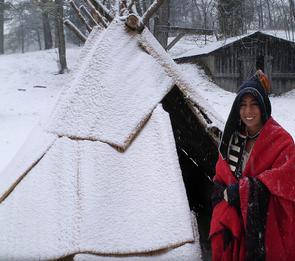 |
| The sugar season brings surprising weather, from snow and ice to 70 degree weather and a nearby tornado - we've seen it all, and work in it all. |
|
|
The following three photos of our sugar camp are by David Black, and were taken at Leane and Micheal's Sugarbush during their Annual Maple Syrup Festival in 2008.
|
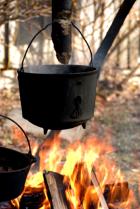 |
| Boiling Maple sap. |
|
|
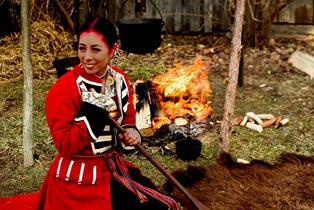 |
| Jessica takes a break from sugaring. |
|
|
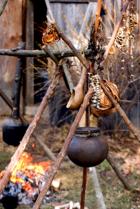 |
| An earthenware pot hangs on the tripod. These were the original Native pots used in reducing sap to syrup. |
|
|
If you are interested in this program, please contact Jessica at events@woodlandindianedu.com.
Because the Maple sugar season is time sensitive, please reserve this program early. We are automatically booked at Maple Syrup Festivals for the last weekend in February and the first two weekends in March. This should not be a problem for more Northern areas whose sugar seasons end later, and whose festivals may be scheduled later.
Also keep in mind that we can still demonstrate sugar making in the absence of a sap flow. We have for certain programs "created" maple sap by dissolving syrup into water. We especially do this for events centered on Native lifeways that may take place any time of the year. If you are interested in this program but fear the timing may make it impossible to present, please contact us first. We may have solutions that help. We have demonstrated sugar making in Summer and Fall.
|
|